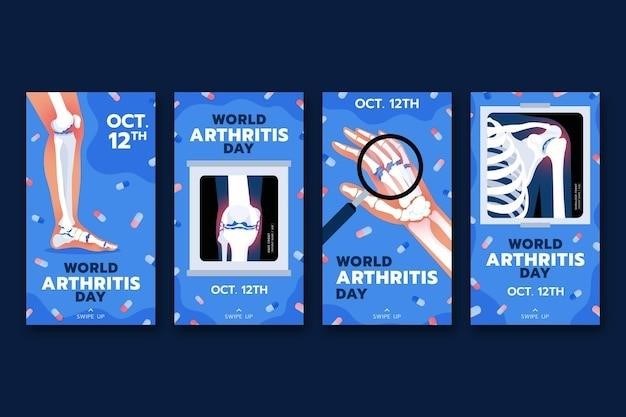Tibial Plateau Fracture Rehab Protocol⁚ A Comprehensive Guide
Tibial plateau fractures are serious injuries that can significantly impact your mobility and quality of life. Rehabilitation is a crucial part of recovery, and a well-structured protocol can help you regain strength, flexibility, and function. This comprehensive guide provides a detailed overview of a typical tibial plateau fracture rehab protocol, outlining the different phases, exercises, and important considerations for optimal healing and return to activities.
Introduction
A tibial plateau fracture is a break in the upper portion of the shinbone (tibia), specifically the area where it connects to the knee joint. This injury can significantly impact your mobility and quality of life, often requiring surgery and extensive rehabilitation to regain function. The tibial plateau, being the weight-bearing surface of the knee, plays a critical role in supporting the body’s weight and enabling smooth movement. A fracture in this area disrupts these functions, leading to pain, instability, and difficulty walking.
This comprehensive guide delves into the intricacies of tibial plateau fracture rehabilitation, providing valuable information for patients and healthcare professionals alike. We will discuss the different phases of recovery, focusing on the specific goals and exercises for each stage. Understanding the rehabilitation process empowers patients to actively participate in their recovery, maximizing their chances of a successful outcome.
The information provided in this guide is intended to serve as a general overview of a typical tibial plateau fracture rehab protocol. It is essential to consult with your orthopedic surgeon and physical therapist for a personalized plan tailored to your individual needs and injury severity.

The information in this guide is for general knowledge and informational purposes only, and does not constitute medical advice. It is essential to consult with a qualified healthcare professional for any health concerns or before making any decisions related to your health or treatment.
What is a Tibial Plateau Fracture?
A tibial plateau fracture is a break in the upper, wider portion of the shinbone (tibia), specifically the area where it articulates with the knee joint; This area, known as the tibial plateau, serves as the weight-bearing surface of the knee, supporting the body’s weight and enabling smooth movement. A fracture in this area disrupts these functions, leading to pain, instability, and difficulty walking.
Tibial plateau fractures are often caused by high-energy trauma, such as motor vehicle accidents, falls from heights, and sports-related injuries. The mechanism of injury usually involves a combination of forces, including twisting, bending, and compression. The severity of the fracture can vary, ranging from small, isolated cracks to large, complex fractures that involve multiple fragments of bone.
These fractures can also be classified based on the location of the break⁚ lateral, medial, or bicondylar (involving both sides of the tibial plateau). The classification system helps guide treatment decisions and predict the potential for complications.
Tibial plateau fractures are complex injuries that require careful evaluation and management. A comprehensive assessment by an orthopedic surgeon is essential to determine the extent of the injury, identify any associated ligament or meniscus damage, and develop an appropriate treatment plan.
Tibial Plateau Fracture Rehab Protocol⁚ Overview
Rehabilitation after a tibial plateau fracture is a crucial process that aims to restore function, reduce pain, and facilitate a safe return to activities. The overall goal is to regain full knee motion, strength, stability, and proprioception (awareness of body position). A typical rehab protocol follows a progressive approach, starting with early protection and gradually advancing to more challenging exercises and activities.
The duration of rehabilitation varies depending on the severity of the fracture, the type of treatment (surgical or non-surgical), and individual factors such as age, fitness level, and overall health. Generally, the rehabilitation process can take several months, with gradual progress and adjustments along the way.
A comprehensive rehab protocol typically involves three distinct phases⁚
- Phase 1⁚ Initial Protection (0-6 Weeks)⁚ This phase focuses on controlling pain and inflammation, protecting the healing fracture, and restoring basic knee motion. It involves non-weight-bearing activities, immobilization, and gentle range of motion exercises.
- Phase 2⁚ Controlled Motion (6-12 Weeks)⁚ As healing progresses, the focus shifts to increasing range of motion, strengthening muscles around the knee, and gradually increasing weight-bearing tolerance. This phase may involve the use of assistive devices, bracing, and more advanced exercises.
- Phase 3⁚ Return to Activity (12+ Weeks)⁚ This phase focuses on gradually returning to functional activities and sports, progressively increasing the intensity and complexity of exercises and activities. It involves functional training, sport-specific drills, and gradual return to desired levels of activity.
This structured approach ensures that healing occurs properly while progressively restoring function and minimizing the risk of re-injury. Regular monitoring and adjustments by your physical therapist are essential for optimal outcomes and safe progression.
Phase 1⁚ Initial Protection (0-6 Weeks)
The initial phase of rehabilitation focuses on protecting the healing fracture, controlling pain and inflammation, and minimizing swelling. This phase typically lasts for the first 6 weeks after surgery or the onset of the injury. The primary goals during this phase are⁚
- Pain and Swelling Management⁚ Ice, compression, and elevation (RICE) are essential for reducing pain and inflammation. Medications, such as pain relievers and anti-inflammatories, may be prescribed to manage discomfort.
- Non-Weight-Bearing⁚ To allow the fracture to heal properly, you will be instructed to avoid putting weight on the injured leg. You will likely use crutches or a walker for mobility during this phase.
- Immobilization⁚ Depending on the severity of the fracture and the type of treatment received, you may need to wear a brace or cast to immobilize the knee joint. This helps to stabilize the fracture and protect it from further injury.
- Gentle Range of Motion Exercises⁚ Once the initial pain and inflammation subside, your physical therapist will guide you through gentle range of motion exercises for the knee. This helps maintain flexibility, prevent stiffness, and promote healing.
- Quadriceps Strengthening⁚ Gentle quadriceps strengthening exercises may be introduced during this phase. These exercises focus on strengthening the muscles around the knee, which are crucial for knee stability and function.
The duration of this phase can vary based on individual factors and the severity of the fracture. Your physical therapist will monitor your progress closely and make adjustments to the rehabilitation program as needed.
Phase 2⁚ Controlled Motion (6-12 Weeks)
As the fracture heals and pain subsides, the focus shifts to regaining controlled motion and increasing strength in the knee joint. This phase typically spans from weeks 6 to 12 post-surgery or injury. During this phase, you can expect to progress through the following⁚
- Weight-Bearing Progression⁚ Your physical therapist will guide you in gradually increasing weight-bearing on the injured leg. This may start with partial weight-bearing using crutches or a walker, and gradually progress to full weight-bearing as tolerated.
- Increased Range of Motion⁚ Range of motion exercises will become more extensive, aiming to restore full flexion and extension of the knee joint. This may involve active assisted range of motion (AAROM) exercises, where you actively move the knee with assistance, and passive range of motion (PROM) exercises, where the therapist moves your knee for you.
- Strengthening Exercises⁚ Strength training exercises will be introduced to improve the strength of the muscles around the knee, including the quadriceps, hamstrings, and calf muscles. These exercises may include bodyweight exercises, resistance band exercises, and light weights.
- Proprioceptive Exercises⁚ Proprioceptive exercises, which focus on improving balance and coordination, are introduced in this phase. These exercises help you regain control and stability in your knee joint. Examples include standing on one leg, walking on uneven surfaces, and performing balance exercises on a wobble board.
The progress in this phase will depend on your individual healing rate and tolerance to exercise. Regular physical therapy sessions are essential for monitoring progress and making adjustments to the rehabilitation program.
Phase 3⁚ Return to Activity (12+ Weeks)
Once you have achieved sufficient strength, flexibility, and functional stability in your knee, you can begin to gradually return to your desired activities. This phase typically starts after 12 weeks, but the duration may vary depending on the severity of the fracture and your individual recovery. This phase is all about regaining the functional capacity and confidence to participate in your daily activities and hobbies. The focus is on⁚
- Functional Exercises⁚ Exercises that mimic your everyday activities are incorporated, such as walking, stair climbing, squatting, and jumping. These exercises help you build strength and endurance for real-life tasks.
- Sport-Specific Training⁚ If you are an athlete, you will work with your physical therapist to develop a sport-specific training program that gradually progresses your activity levels, starting with low-impact exercises and gradually increasing the intensity and complexity.
- Gradual Return to Activity⁚ Your physical therapist will guide you in gradually returning to your desired activities, starting with light activities and slowly increasing the intensity and duration as tolerated. This approach helps to prevent re-injury and ensure a safe and successful return to activity.
- Functional Testing⁚ Functional tests may be performed to assess your knee’s stability, strength, and endurance. These tests help determine if you are ready to return to your desired activities.
Remember that every individual heals at their own pace. It’s crucial to listen to your body and avoid pushing yourself too hard too soon. Your physical therapist will monitor your progress and provide guidance throughout this phase, ensuring a safe and successful return to your desired activities.
Exercises for Tibial Plateau Fracture Rehab
The specific exercises you’ll perform will depend on the severity of your fracture, your overall fitness level, and your individual needs. A typical rehabilitation program includes exercises targeting⁚
- Range of Motion (ROM)⁚ Exercises to improve the flexibility and mobility of your knee joint. These might include gentle knee flexion and extension, as well as circular movements.
- Quadriceps Strengthening⁚ Exercises to strengthen the muscles on the front of your thigh, which help extend your knee. Examples include straight leg raises, quadriceps sets, and knee extensions with a resistance band.
- Hamstring Strengthening⁚ Exercises to strengthen the muscles on the back of your thigh, which help to bend your knee. Examples include hamstring curls, heel raises, and bridging exercises.
- Calf Strengthening⁚ Exercises to strengthen your calf muscles, which help with ankle stability and push-off during walking. Examples include calf raises and heel walks.
- Proprioception⁚ Exercises to improve your balance and coordination, helping you regain control and stability in your knee joint. Examples include standing on one leg, heel-toe walking, and balance board exercises.
- Functional Exercises⁚ Exercises that mimic everyday activities, such as walking, stair climbing, squatting, and jumping. These exercises prepare you for a safe return to your desired activities.
Your physical therapist will guide you through these exercises, ensuring proper form and progression. They will also adjust the intensity and difficulty of the exercises based on your individual needs and progress. It’s important to listen to your body and stop if you experience any pain. Consistent exercise is key to achieving optimal recovery and restoring function to your knee.
Important Considerations for Rehabilitation

While following your rehab protocol is crucial, several other factors can significantly impact your recovery. These considerations ensure your safety and maximize your healing potential⁚
- Pain Management⁚ Pain is a natural part of the healing process, but it’s essential to manage it effectively. Your doctor will prescribe pain medication and recommend pain-relieving techniques like ice, elevation, and rest. Communicate any pain concerns to your doctor or physical therapist.
- Swelling Management⁚ Swelling is common after a tibial plateau fracture. Elevate your leg above your heart for the first few days and use ice packs to reduce swelling. Compression bandages can also help.
- Weight-Bearing Restrictions⁚ You’ll likely be placed on non-weight-bearing restrictions for a period, using crutches or a walker for mobility. Follow your doctor’s weight-bearing instructions carefully to allow the fracture to heal properly.
- Early Motion⁚ Gentle range of motion exercises are important even in the early stages of healing. This helps prevent stiffness and promotes blood flow to the injured area.
- Compliance with Protocol⁚ Adherence to your rehab protocol is essential. Attend all therapy sessions, complete your home exercises, and follow your doctor’s instructions carefully.
- Patience and Realistic Expectations⁚ Recovering from a tibial plateau fracture takes time and effort. Be patient with yourself and set realistic expectations. Progress may not always be linear, and setbacks are possible. Focus on making consistent progress and celebrate your achievements along the way.
By paying close attention to these considerations, you can maximize your chances of a successful recovery and regain full function in your knee.
Recovering from a tibial plateau fracture can be a challenging journey, but with a comprehensive rehab protocol and a commitment to recovery, you can regain your mobility and return to your active lifestyle. This guide has provided a detailed framework for understanding the stages of rehabilitation, the importance of exercises, and crucial considerations for optimal healing. Remember, every individual’s recovery process is unique, and your progress may vary.
Closely follow your doctor’s instructions, attend physical therapy sessions diligently, and be patient with yourself. Consistent effort and adherence to the protocol will maximize your chances of a successful recovery. If you experience any unusual pain, swelling, or limitations, don’t hesitate to contact your doctor or physical therapist for guidance. With dedication and proper care, you can overcome this injury and enjoy a fulfilling and active life.
This comprehensive guide serves as a valuable resource for patients, families, and healthcare professionals involved in the rehabilitation of tibial plateau fractures. By utilizing this information, you can work collaboratively with your healthcare team to achieve optimal outcomes and regain your desired level of function.



